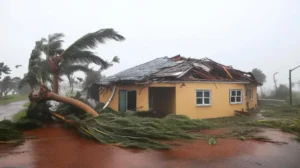A 4-Point Inspection is an essential step for homeowners and buyers in the Miami area, especially when dealing with insurance companies. If you’re curious about what this inspection involves and the common issues that tend to pop up, this guide will help answer your questions.
1. What Is a 4-Point Inspection?
A 4-Point Inspection is a specialized assessment that focuses on four key areas of a home: the roof, electrical system, plumbing, and HVAC (heating, ventilation, and air conditioning). This type of inspection is often required by insurance companies, especially for homes that are over 20 years old. The goal is to evaluate the age, condition, and functionality of these critical systems to determine the risk level for insurers.
2. Why Do Insurance Companies Require a 4-Point Inspection?
Insurance companies in Miami require a 4-Point Inspection to assess the risk of insuring older homes. Since Miami is prone to hurricanes, flooding, and other weather-related issues, insurers want to ensure that the main systems in your home are in good condition. If problems are found during the inspection, you may be required to make repairs before getting coverage or renewing your policy. This inspection helps insurance companies manage their risk while giving homeowners a chance to fix potential problems.
3. What Are the Most Common Issues Found During a 4-Point Inspection?
Certain issues tend to come up frequently during a 4-Point Inspection, especially in older homes in Miami:
- Roof Problems: Missing or damaged shingles, leaks, and roofs that are nearing the end of their lifespan are common issues. Since Miami experiences heavy rain and hurricanes, the roof’s condition is a top concern.
- Electrical Issues: Outdated electrical panels, faulty wiring, and lack of grounding are frequent problems. Homes with aluminum wiring or older panels like Federal Pacific or Zinsco may require upgrades.
- Plumbing Problems: Leaking pipes, outdated plumbing materials like polybutylene, and water heater issues are often found. Miami’s humid climate can also lead to corrosion, which may affect plumbing systems.
- HVAC Issues: Old or poorly maintained HVAC systems, lack of proper ventilation, and issues with the air conditioning unit can be red flags. In Miami’s hot and humid weather, a functioning HVAC system is crucial for comfort and health.
4. Can I Fail a 4-Point Inspection?
The concept of “failing” a 4-Point Inspection is a bit misleading. The inspection doesn’t pass or fail like a traditional home inspection; instead, it highlights the current condition of your home’s key systems. If serious issues are found, your insurance company might require you to fix them before providing or renewing coverage. The inspection report gives you the opportunity to address these problems and improve your home’s insurability.
5. How Can I Prepare for a 4-Point Inspection?
To prepare for a 4-Point Inspection, it’s a good idea to do some basic checks yourself:
- Roof: Look for visible signs of damage like missing shingles or leaks. If your roof is over 15 years old, consider getting it inspected by a professional roofer before the 4-Point Inspection.
- Electrical: Make sure your home’s wiring and electrical panels are up to date. If your home has an older panel or aluminum wiring, consult an electrician about potential upgrades.
- Plumbing: Check for leaks, rust, or corrosion in your pipes. Ensure your water heater is in good working condition and doesn’t show signs of wear.
- HVAC: Have your HVAC system serviced to ensure it’s running efficiently. Clean or replace air filters and check for any issues with your air conditioning unit.
A 4-Point Inspection in the Miami area is a critical step for homeowners, especially when dealing with insurance. Understanding what the inspection covers, why it’s required, and what issues are commonly found can help you prepare and address any problems in advance. By taking these steps, you can ensure that your home is in good shape and ready for the challenges of Miami’s climate while keeping your insurance coverage intact.






